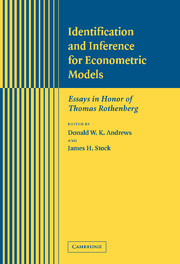Book contents
- Frontmatter
- Contents
- List of Contributors
- Preface
- Part I Identification and Efficient Estimation
- 1 Incredible Structural Inference
- 2 Structural Equation Models in Human Behavior Genetics
- 3 Unobserved Heterogeneity and Estimation of Average Partial Effects
- 4 On Specifying Graphical Models for Causation and the Identification Problem
- 5 Testing for Weak Instruments in Linear IV Regression
- 6 Asymptotic Distributions of Instrumental Variables Statistics with Many Instruments
- 7 Identifying a Source of Financial Volatility
- Part II Asymptotic Approximations
- Part III Inference Involving Potentially Nonstationary Time Series
- Part IV Nonparametric and Semiparametric Inference
1 - Incredible Structural Inference
Published online by Cambridge University Press: 24 February 2010
- Frontmatter
- Contents
- List of Contributors
- Preface
- Part I Identification and Efficient Estimation
- 1 Incredible Structural Inference
- 2 Structural Equation Models in Human Behavior Genetics
- 3 Unobserved Heterogeneity and Estimation of Average Partial Effects
- 4 On Specifying Graphical Models for Causation and the Identification Problem
- 5 Testing for Weak Instruments in Linear IV Regression
- 6 Asymptotic Distributions of Instrumental Variables Statistics with Many Instruments
- 7 Identifying a Source of Financial Volatility
- Part II Asymptotic Approximations
- Part III Inference Involving Potentially Nonstationary Time Series
- Part IV Nonparametric and Semiparametric Inference
Summary
INTRODUCTION
In the course of their everyday work, economists routinely employ statistical techniques to analyze data. Typically, these techniques are based on probability models for the observations and justified by an appeal to the theory of statistical inference. An important example is the estimation of structural equations relating economic variables. Such equations are interpreted as representing causal mechanisms and are widely used for forecasting and policy analysis. This econometric approach is arguably the dominant research methodology today among applied economists both in and out of academia.
The econometric approach is not without its critics. Scholars from other disciplines often seem puzzled by the emphasis that economists place on regression analysis. Statisticians express surprise that their techniques should be applicable to so many situations. Recently, a number of leading econometricians have added to the critique. In his paper “Let's Take the Con Out of Econometrics,” Ed Leamer (1983) chides economists for ignoring the fragility of their estimates. The title of this paper comes from Christopher Sims's (1980) paper “Macroeconomics and Reality,” which argues that the economic and statistical assumptions underlying most macromodels are not believable. They are, he asserts, literally “incredible.”
Although my purpose is similar to that of Leamer and Sims, my approach will be rather different. In any area of application there will always be differences of opinion on what constitutes a reasonable set of assumptions on which to base the statistical analysis. Particularly in macroeconomics, where one is trying to summarize in a manageable aggregate model the behavior of millions of decision makers with regard to thousands of products, the disagreements are bound to be enormous.
Information
- Type
- Chapter
- Information
- Identification and Inference for Econometric ModelsEssays in Honor of Thomas Rothenberg, pp. 3 - 10Publisher: Cambridge University PressPrint publication year: 2005
